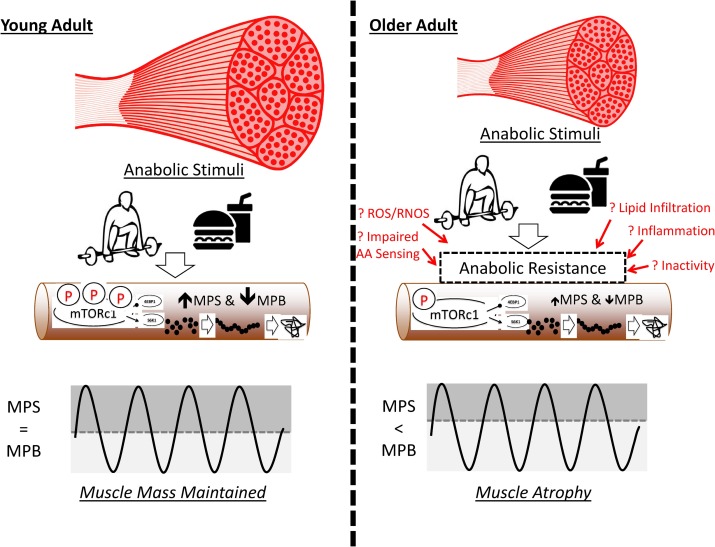Ageing Research Reviews ( IF 12.5 ) Pub Date : 2018-07-23 , DOI: 10.1016/j.arr.2018.07.005 D J Wilkinson 1 , M Piasecki 1 , P J Atherton 1

|
Age-related loss of skeletal muscle mass and function, sarcopenia, is associated with physical frailty and increased risk of morbidity (chronic diseases), in addition to all-cause mortality. The loss of muscle mass occurs incipiently from middle-age (∼1%/year), and in severe instances can lead to a loss of ∼50% by the 8–9th decade of life. This review will focus on muscle deterioration with ageing and highlight the two underpinning mechanisms regulating declines in muscle mass and function: muscle fibre atrophy and muscle fibre loss (hypoplasia) – and their measurement. The mechanisms of muscle fibre atrophy in humans relate to imbalances in muscle protein synthesis (MPS) and breakdown (MPB); however, since there is limited evidence for basal alterations in muscle protein turnover, it would appear that “anabolic resistance” to fundamental environmental cues regulating diurnal muscle homeostasis (namely physical activity and nutrition), underlie age-related catabolic perturbations in muscle proteostasis. While the ‘upstream’ drivers of the desensitization of aged muscle to anabolic stimuli are poorly defined, they most likely relate to impaired efficiency of the conversion of nutritional/exercise stimuli into signalling impacting mRNA translation and proteolysis. Additionally, loss of muscle fibres has been shown in cadaveric studies using anatomical fibre counts, and from iEMG studies demonstrating motor unit loss, albeit with few molecular investigations of this in humans. We suggest that defining countermeasures against sarcopenia requires improved understandings of the co-ordinated regulation of muscle fibre atrophy and fibre loss, which are likely to be inextricably linked.
中文翻译:

与年龄相关的骨骼肌质量和功能损失:人类肌纤维萎缩和肌纤维损失的测量和生理学
除了全因死亡率外,与年龄相关的骨骼肌质量和功能丧失、肌肉减少症与身体虚弱和发病(慢性病)风险增加有关。肌肉量的减少从中年开始(~1%/年),在严重的情况下会导致到 8-9 岁的时候减少~50%。本综述将重点关注随着衰老而导致的肌肉退化,并强调调节肌肉质量和功能下降的两种基础机制:肌纤维萎缩和肌纤维丧失(发育不全)——以及它们的测量。人类肌肉纤维萎缩的机制与肌肉蛋白质合成 (MPS) 和分解 (MPB) 的不平衡有关;然而,由于肌肉蛋白质转换的基础改变的证据有限,似乎对调节昼夜肌肉稳态(即身体活动和营养)的基本环境线索的“合成代谢抵抗”是肌肉蛋白质稳态中与年龄相关的分解代谢扰动的基础。虽然老年肌肉对合成代谢刺激脱敏的“上游”驱动因素定义不明确,但它们很可能与营养/运动刺激转化为影响 mRNA 翻译和蛋白水解的信号传导的效率受损有关。此外,使用解剖纤维计数的尸体研究和 iEMG 研究表明,肌肉纤维的损失已显示出运动单位损失,尽管很少有人对此进行分子研究。

































 京公网安备 11010802027423号
京公网安备 11010802027423号